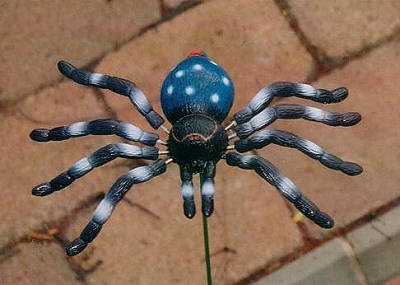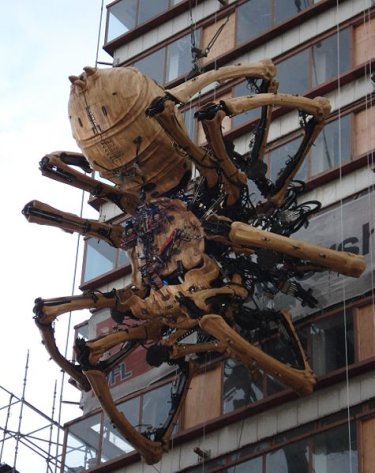This fantastic air-powered 16 foot tall spider puppet is made by Tim Davies. Wired.co.uk has more technical details about the structure and how it operates. (I think this information must come from the artist’s site, but it is down at the moment).
spider
La Princesse
This great spider is one of the newest creatures by the French company, La Machine (that I posted about a few days ago). Known as la Princesse, her performance in the streets of Liverpool, England, last September was a highlight of the 2008 European Capital of Culture celebrations there. She was commissioned by Artichoke, the company who brought Royal de Luxe‘s Sultan’s Elephant to London a few years ago.
A giant spider conjures up dramatic visions of Shelob, huge rearing fangs, giant trapdoors, buildings being webbed in, or the populace being picked off one by one and spun into food parcels, tasty morsels for later. But in one of the BBC videos, her creator, Francois Delaroziere, described the emotion he wanted to provoke as ‘sweet and in love’.
There are squillions of photos of la Princesse online now; here a few links as starters:
Flickr pool
La Machine’s webpage on the event
Main BBC webpage (portal) about the event
Revealed: The secrets of the 50ft robo-spider – ‘There is never a dull moment in Liverpool’ :)
From my garden
I happened to notice this tiny baby gecko trapped in a spider’s web outside my studio window yesterday. It was only an inch or so long. At first I thought it was one of the little sleek brown skinks, as we have lots of those, and the gecko’s distinctive pads on its fingers were not easy to see. I’m fond of both, but especially geckos, and I don’t see them very often.
It’s tail was very securely fastened to the web, which made me think it had been properly caught, rather than had just wandered into the web and got tangled. Perhaps the spider was waiting for it to weaken, because it hadn’t been poisoned or wrapped up more. I didn’t search for the spider, but maybe it was one of the black house spiders that live under the external window sills. After I had taken a few photos, I rescued the gecko and it ran away into the tanbark. It surprised me thinking about it afterwards that it hadn’t shed it’s tail to get away as both geckos and skinks can. Maybe tail shedding ability only comes with age?
Also from my garden, a moth with great camouflage, sitting on a towel on the washing line the other day. From other angles it was even more the colour of the towel. Underneath though, it was very colourful, and it had masked face like a bandit, and a shape that made me think of stealth bombers.
There are a few more photos in my Backyard set at Flickr.
Hooray for two-dollar shops!
Tacky but interesting: this is a huge spider garden spike that I got at the $2 shop the other day. It’s a hand span across, and the connections between its legs and body are fine springs, so that when the spike is jolted the legs have an incidental movement. The best movement you can get out of it is a kind of drumming of the legs, where, on each side, legs 1 and 3 are in sync with each other, and legs 2 and 4 are doing the opposite. Then it has the right kind of action for a huntsman spider.

I have a couple of other insect garden spikes, a bee and a dragonfly (bought out of curiosity when I was working on making giant bees and dragonflies a few years ago). They are much smaller than the spider, with bodies about 7 cm long, and the wings are on double springs. The dragonfly has much lighter springs, and a much better incidental movement than the poor bee, whose springs and wings are way too heavy.





